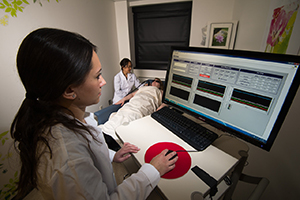URMC / Labs / Choe Lab / Projects / Diffuse Optical Techniques for Breast Cancer Therapy Monitoring
Diffuse Optical Techniques for Breast Cancer Therapy Monitoring
 Neoadjuvant (i.e. pre-surgical) chemotherapy is an important therapeutic approach for women with locally advanced breast cancer. Typically, such breast cancers are large (e.g. larger than 5 cm) and many anticipated responses to drugs are vascular in nature. It is desirable for treatment optimization to monitor tumor responses during this process. In particular, alterations in tumor biology and physiology due to chemotherapy can be seen via positron emission tomography (PET) or dynamic contrast enhanced magnetic resonance imaging (DCE-MRI) before morphological changes. DCE-MRI and PET, however, are expensive and are not practical for frequent monitoring. Diffuse optical techniques are especially attractive in this context, since they provide physiological information directly related to tumor vascularity and oxygenation with inexpensive, non-ionizing and non-invasive instrumentation.
Neoadjuvant (i.e. pre-surgical) chemotherapy is an important therapeutic approach for women with locally advanced breast cancer. Typically, such breast cancers are large (e.g. larger than 5 cm) and many anticipated responses to drugs are vascular in nature. It is desirable for treatment optimization to monitor tumor responses during this process. In particular, alterations in tumor biology and physiology due to chemotherapy can be seen via positron emission tomography (PET) or dynamic contrast enhanced magnetic resonance imaging (DCE-MRI) before morphological changes. DCE-MRI and PET, however, are expensive and are not practical for frequent monitoring. Diffuse optical techniques are especially attractive in this context, since they provide physiological information directly related to tumor vascularity and oxygenation with inexpensive, non-ionizing and non-invasive instrumentation.
The feasibility of applying diffuse optical techniques in the context of cancer therapy monitoring has been demonstrated by good correlation between changes in physiological parameters and patient response to chemotherapy. In order to translate diffuse optical technique from a prototype stage to a routine clinical application stage, statistically significant population data and optimization of technique are necessary. To this vein, we aim to optimize instrumentation and analysis for real-time clinical monitoring, and to identify which oxygen-metabolism related parameters (e.g. blood flow, blood oxygen saturation and total hemoglobin concentration) can predict neoadjuvant chemotherapy efficacy before morphological changes manifest themselves.
« back to all projects